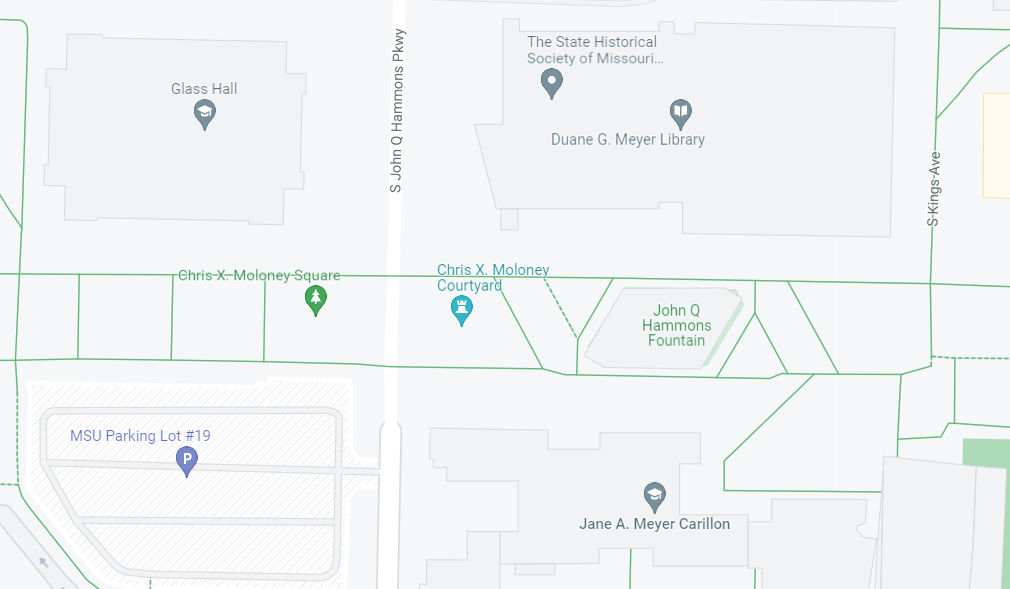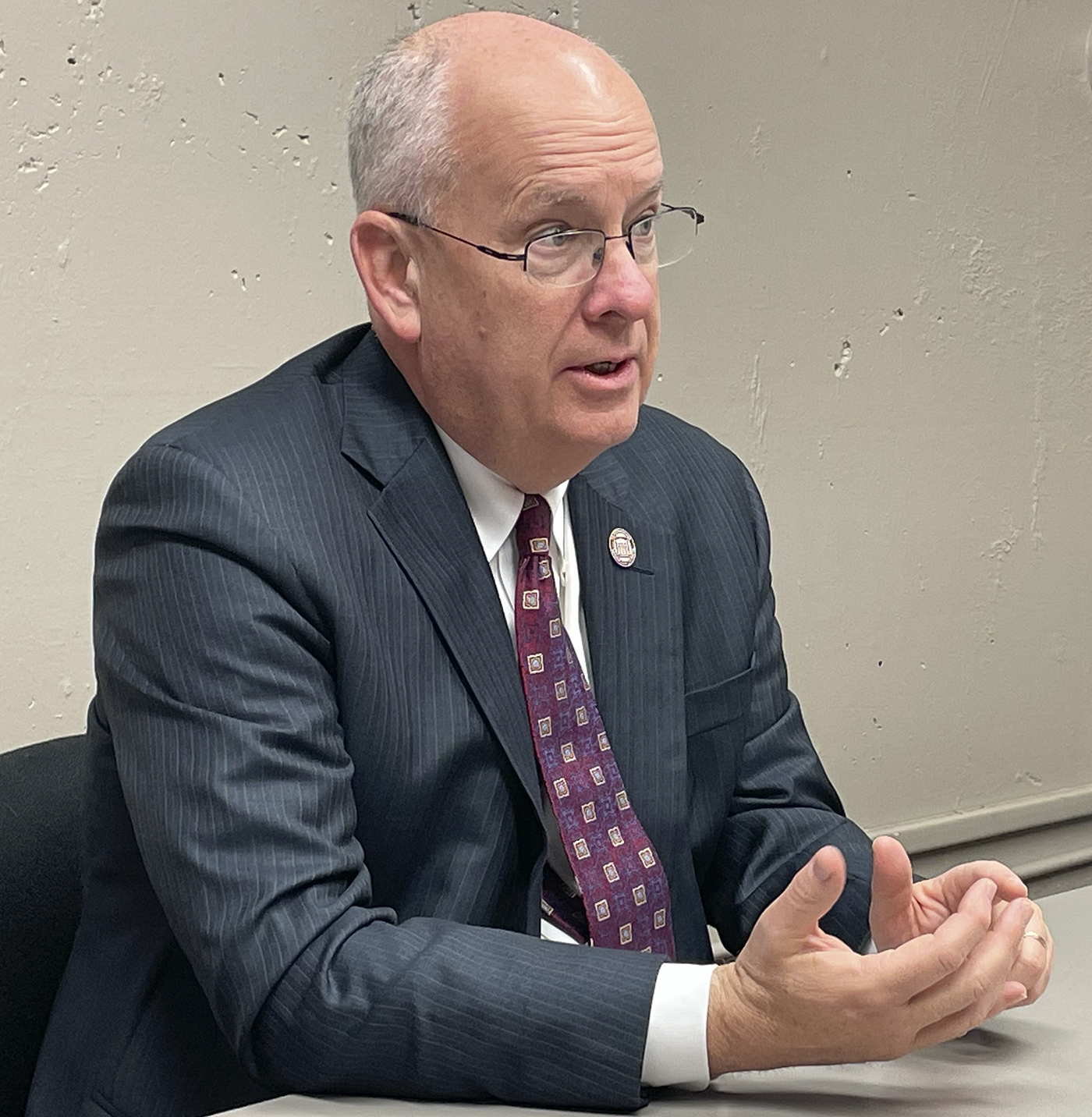OPINION |
My footsteps seem to echo as I cross the expanse of the Missouri State University campus.
It's a Friday. I'm headed to the office of the Hauxeda, which is in the lower level of a residence hall. The campus feels empty and hollow on Fridays. The carillon chimes for the lonely.
Rarely on Fridays do I spot one of the little robots that scurry about delivering food Monday through Thursday. Far fewer students zip by on motorized scooters.
On Fridays, no one is here to hand me a tract about Jesus.

Wait a minute! I need to digress here
I wonder as I walk along the “Chris X. Moloney Square” and the “Chris X. Moloney Courtyard” about the …
Wait. Let me back up. I'm going to digress.
Who is Chris X. Moloney? Why do two patches of campus grass bear his name on a Google map of the campus?

(In writing this column, I blew up a Google campus map — not the map on the MSU website — to double-check the names of the buildings I pass on my way to the office. Only then did I discover the puzzling legacy of Chris X. Moloney.)
The courtyard and the square were news even to Christopher Xavier Moloney when I called him.
Moloney is a successful businessman who lives in Dallas. He graduated from Missouri State in 1993, where he was managing editor of the student newspaper and, lo and behold, he once worked as a page designer at the Springfield News-Leader.
From 2010 to 2016, Moloney was on the Board of Advisors to MSU's College of Business.
Still, the thought of online skullduggery crosses my mind, because when I look closer at the Google map, I notice that the Jane A. Meyer Carillon is shown sprouting out of Temple Hall. In reality, the tower is on the other side of the quadrangle and is part of the library.
Master fundraiser Brent Dunn, MSU's vice president for university advancement, has never heard of either the square or the courtyard bearing Moloney's name.
(My conclusion is that someone has playfully altered a Google map. Colleague Rance Burger now wants to see if he can surreptitiously alter a Google map so that an MSU parking lot bears my name. I'm fearful that if he succeeds, Dunn will soon be asking me for a naming-rights donation.)
Where was I? Oh, back to Friday classes

OK. Enough digression. Let me resume where I left off.
I contacted Andrea Mostyn, assistant director of university communications, and asked her for the number of students enrolled in seated classes during the day on the Springfield campus for each week day.
Here's the information for this semester.
(It does not include classes that start after 4 p.m. And if the same student is enrolled in four separate classes on the same day — that student is counted four times.)
Mondays 28,108 students
Tuesdays 28,635 students
Wednesdays 29,294 students
Thursdays 28,026 students
Fridays 16,648 students
The numbers confirm what I thought, and, I suspect, no one is surprised that college students try to avoid Friday classes.

But not so fast. The same pattern does not occur at Drury or Evangel, because students there have only two options regarding daytime, seated class schedules: it's either Monday/Wednesday/Friday or longer sessions offered on Tuesday/Thursday.
In other words, at Drury and Evangel, the number of students taking classes should be the same, in theory, on Mondays, Wednesdays and on Fridays.
(I suspect, however, that Friday forever will be the No. 1 day for cutting class.)
Do we possibly have a trend here?
I asked Clif Smart, president of MSU: Is there a trend here? Will Friday classes soon be a thing of the past in higher education?

Or is there not a trend — words no reporter halfway into a story ever wants to hear —and things are the same as they ever were?
Smart says there might be two factors at MSU that, in recent years, have lowered Friday enrollments in seated classes.
First, a few years ago, the College of Business — the motherlode of MSU student enrollment — responded to what business students preferred. They wanted either Monday/Wednesday classes or Tuesday/Thursday classes.
You do not see the word “Friday” in that.
The other factor is the growing number of hybrid classes where students meet in person as well as online or on Zoom.
“No one is going to pick Friday for that in-person class time,” Smart says.
Business dean says no Fridays makes sense
MSU this semester has 4,677 students in the College of Business, says Dean David Meinert. Very few of them have a Friday business class.
The push to do away with Friday business classes was in 2021, he says, but the college was already heading in that direction.
The need to have space for seated classes on all five days is not as intense as it once was, he says.
First, there are more hybrid classes and technological advances such as Blackboard, a web-based virtual learning environment where students can ask questions 24/7.
Use of all these online options was accelerated by COVID-19, he says.
Students like it, faculty members like it

Students like not having Friday classes because it helps them better manage their time for things like part-time jobs, full-time jobs and internships, Meinert says.
In addition, he says, many business students travel to compete in weekend competitions in subject areas such as cybersecurity or construction management.
Faculty like it, Meinert says, in part because it makes it easier to gather for business-college meetings.
Don't forget, he says, three 50-minute classes a week is the same instruction time as two 75-minute classes a week.
Smart says the plus side of having fewer classes on Fridays is that the university is responding to what students prefer.
“Eighty-percent of our students work,” Smart says. “We don't have many 1-percenters at Missouri State. Working is part of their strategy.”
Possible downside is loss of ‘community'

The possible downside, he says, is that having fewer Friday classes can encourage students to consistently leave campus on three-day weekends. That can defeat the goal of developing a “community feel” for students living and learning on campus.
If students are gone on weekends, he says, it can decrease student attendance at intercollegiate sporting events. Smart says he already has noticed that the student section at home basketball games is fuller at a Tuesday game, for example, than at a game on a Friday or Saturday.
“We don't want to be in a situation where we end up working against ourselves,” he says.
This is Pokin Around column No. 82.

